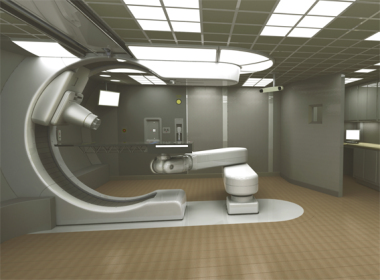University of Oxford
Source: STFC
10 Jan 12

The first results from a new type of particle accelerator suggest how smaller, cheaper therapy machines, which could revolutionise cancer treatment, could be built.
The prototype accelerator EMMA (Electron Model for Many Applications), which was constructed at the Science and Technology Facilities Council’s (STFC) Daresbury Laboratory, was designed by an international team including Oxford University scientists.
Current accelerators – used in medicine in conventional radiation therapy and X-ray machines as well as industry and fundamental scientific research – are limited by their size, complexity and cost.
EMMA’s technology is more compact, cost effective and operationally simpler, allowing the more widespread use of accelerators to tackle some of the most difficult problems facing society. The team report in Nature Physics the first experimental results from EMMA, confirming the proof of principle underlying its technology.
It is hoped that in the future this technology will allow hospitals to implement a newer and more effective form of beam therapy to help cure some of the most difficult cancers.
Professor Ken Peach of the John Adams Institute for Accelerator Science and the Oxford Martin School’s Particle Therapy Cancer Research Institute said: ‘This is a very exciting result – it is very rare these days to discover a new principle of particle acceleration, and this could lead to the development of novel or greatly improved applications of accelerators, for example in the treatment of some forms of cancer.’
EMMA’s ground-breaking concept is based on a ring of magnets which use their combined magnetic field simultaneously to steer and focus the electron beam around the machine. The strength of this magnetic field increases steeply as the beam spirals outwards while it is accelerated to 20 million electron volts around the ring. Due to the strength of the magnetic focussing, the displacement of the beam as it accelerates and spirals around the ring is much smaller than in any equivalent accelerator. As a result, EMMA’s ring of magnets is much more compact and it is easier to accelerate the beam.
The experience gained in the development and operation of EMMA's new technology will inform the design and eventual construction of a prototype proton/carbon ion accelerator for medical applications (PAMELA).
Engineered and constructed at the Science and Technology Facilities Council’s (STFC) Daresbury Laboratory, EMMA was designed by an international consortium of scientists as part of the CONFORM project, which includes the Universities of Manchester, Oxford, Surrey, Imperial, Brunel, Liverpool and Huddersfield, STFC, the Cockcroft and John Adams Institutes, as well as a number of international partners which include the Brookhaven National Laboratory and Fermilab in the US, and TRIUMF in Canada.
©
Source: STFC
10 Jan 12

The EMMA particle accelerator. Photo: STFC
The first results from a new type of particle accelerator suggest how smaller, cheaper therapy machines, which could revolutionise cancer treatment, could be built.
The prototype accelerator EMMA (Electron Model for Many Applications), which was constructed at the Science and Technology Facilities Council’s (STFC) Daresbury Laboratory, was designed by an international team including Oxford University scientists.
Current accelerators – used in medicine in conventional radiation therapy and X-ray machines as well as industry and fundamental scientific research – are limited by their size, complexity and cost.
EMMA’s technology is more compact, cost effective and operationally simpler, allowing the more widespread use of accelerators to tackle some of the most difficult problems facing society. The team report in Nature Physics the first experimental results from EMMA, confirming the proof of principle underlying its technology.
It is hoped that in the future this technology will allow hospitals to implement a newer and more effective form of beam therapy to help cure some of the most difficult cancers.
Professor Ken Peach of the John Adams Institute for Accelerator Science and the Oxford Martin School’s Particle Therapy Cancer Research Institute said: ‘This is a very exciting result – it is very rare these days to discover a new principle of particle acceleration, and this could lead to the development of novel or greatly improved applications of accelerators, for example in the treatment of some forms of cancer.’
EMMA’s ground-breaking concept is based on a ring of magnets which use their combined magnetic field simultaneously to steer and focus the electron beam around the machine. The strength of this magnetic field increases steeply as the beam spirals outwards while it is accelerated to 20 million electron volts around the ring. Due to the strength of the magnetic focussing, the displacement of the beam as it accelerates and spirals around the ring is much smaller than in any equivalent accelerator. As a result, EMMA’s ring of magnets is much more compact and it is easier to accelerate the beam.
The experience gained in the development and operation of EMMA's new technology will inform the design and eventual construction of a prototype proton/carbon ion accelerator for medical applications (PAMELA).
Engineered and constructed at the Science and Technology Facilities Council’s (STFC) Daresbury Laboratory, EMMA was designed by an international consortium of scientists as part of the CONFORM project, which includes the Universities of Manchester, Oxford, Surrey, Imperial, Brunel, Liverpool and Huddersfield, STFC, the Cockcroft and John Adams Institutes, as well as a number of international partners which include the Brookhaven National Laboratory and Fermilab in the US, and TRIUMF in Canada.
©




